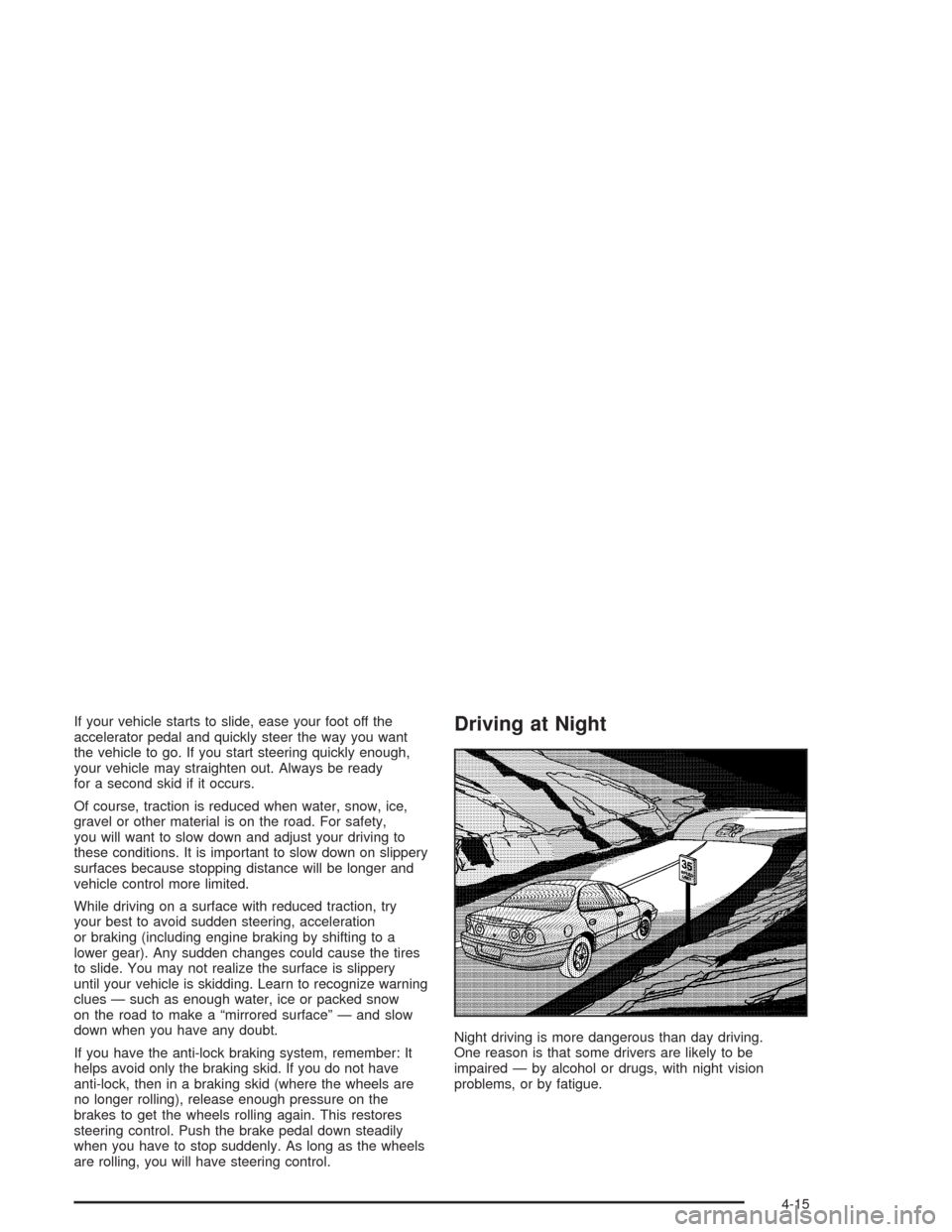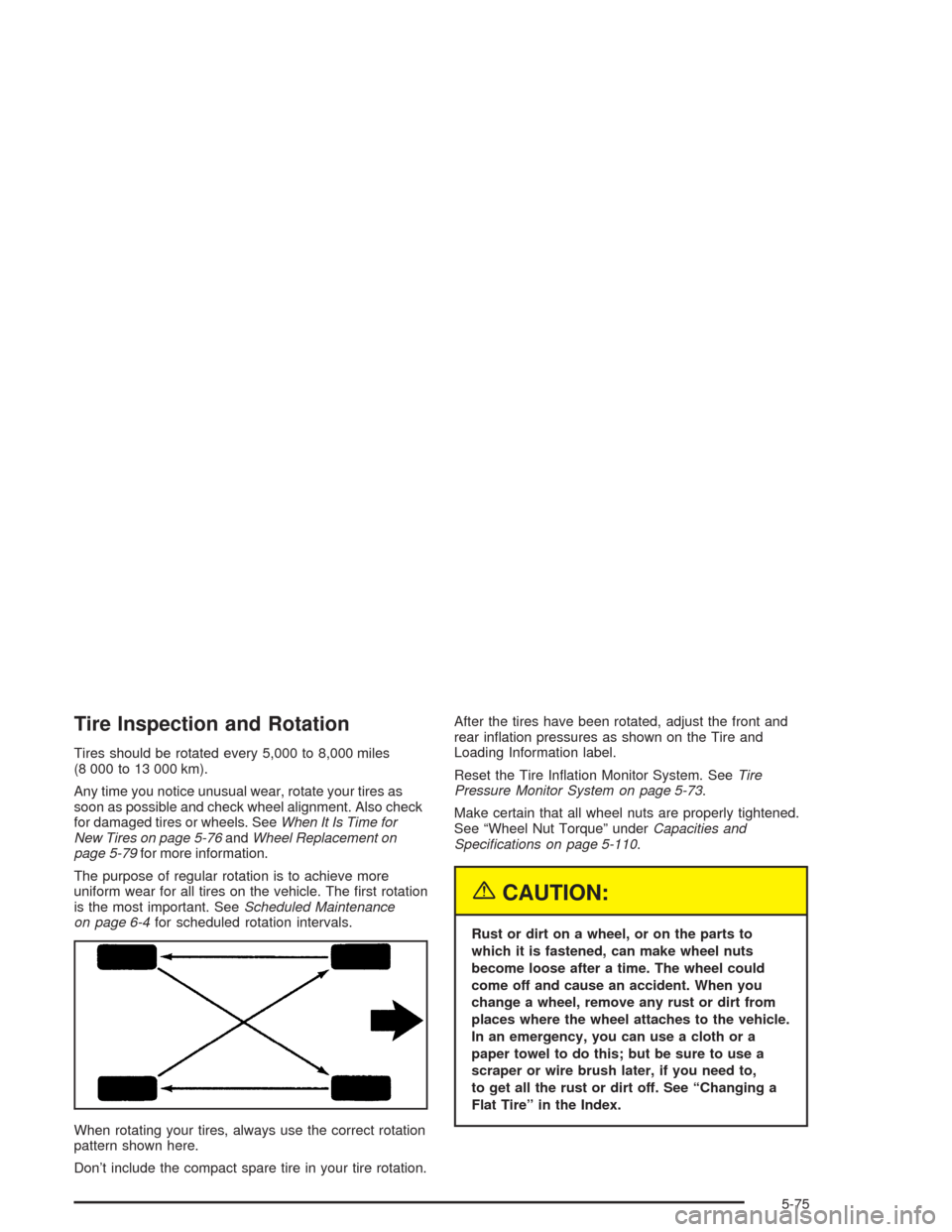Page 233 of 420

If your vehicle starts to slide, ease your foot off the
accelerator pedal and quickly steer the way you want
the vehicle to go. If you start steering quickly enough,
your vehicle may straighten out. Always be ready
for a second skid if it occurs.
Of course, traction is reduced when water, snow, ice,
gravel or other material is on the road. For safety,
you will want to slow down and adjust your driving to
these conditions. It is important to slow down on slippery
surfaces because stopping distance will be longer and
vehicle control more limited.
While driving on a surface with reduced traction, try
your best to avoid sudden steering, acceleration
or braking (including engine braking by shifting to a
lower gear). Any sudden changes could cause the tires
to slide. You may not realize the surface is slippery
until your vehicle is skidding. Learn to recognize warning
clues — such as enough water, ice or packed snow
on the road to make a “mirrored surface” — and slow
down when you have any doubt.
If you have the anti-lock braking system, remember: It
helps avoid only the braking skid. If you do not have
anti-lock, then in a braking skid (where the wheels are
no longer rolling), release enough pressure on the
brakes to get the wheels rolling again. This restores
steering control. Push the brake pedal down steadily
when you have to stop suddenly. As long as the wheels
are rolling, you will have steering control.Driving at Night
Night driving is more dangerous than day driving.
One reason is that some drivers are likely to be
impaired — by alcohol or drugs, with night vision
problems, or by fatigue.
4-15
Page 337 of 420

Tire Inspection and Rotation
Tires should be rotated every 5,000 to 8,000 miles
(8 000 to 13 000 km).
Any time you notice unusual wear, rotate your tires as
soon as possible and check wheel alignment. Also check
for damaged tires or wheels. SeeWhen It Is Time for
New Tires on page 5-76andWheel Replacement on
page 5-79for more information.
The purpose of regular rotation is to achieve more
uniform wear for all tires on the vehicle. The �rst rotation
is the most important. SeeScheduled Maintenance
on page 6-4for scheduled rotation intervals.
When rotating your tires, always use the correct rotation
pattern shown here.
Don’t include the compact spare tire in your tire rotation.After the tires have been rotated, adjust the front and
rear in�ation pressures as shown on the Tire and
Loading Information label.
Reset the Tire In�ation Monitor System. SeeTire
Pressure Monitor System on page 5-73.
Make certain that all wheel nuts are properly tightened.
See “Wheel Nut Torque” underCapacities and
Speci�cations on page 5-110.
{CAUTION:
Rust or dirt on a wheel, or on the parts to
which it is fastened, can make wheel nuts
become loose after a time. The wheel could
come off and cause an accident. When you
change a wheel, remove any rust or dirt from
places where the wheel attaches to the vehicle.
In an emergency, you can use a cloth or a
paper towel to do this; but be sure to use a
scraper or wire brush later, if you need to,
to get all the rust or dirt off. See “Changing a
Flat Tire” in the Index.
5-75
Page 343 of 420

If a Tire Goes Flat
It’s unusual for a tire to “blowout” while you’re driving,
especially if you maintain your tires properly. If air goes
out of a tire, it’s much more likely to leak out slowly.
But if you should ever have a “blowout,” here are a few
tips about what to expect and what to do:
If a front tire fails, the �at tire will create a drag that
pulls the vehicle toward that side. Take your foot off the
accelerator pedal and grip the steering wheel �rmly.
Steer to maintain lane position, and then gently brake to
a stop well out of the traffic lane.
A rear blowout, particularly on a curve, acts much like a
skid and may require the same correction you’d use
in a skid. In any rear blowout, remove your foot from the
accelerator pedal. Get the vehicle under control by
steering the way you want the vehicle to go. It may be
very bumpy and noisy, but you can still steer. Gently
brake to a stop, well off the road if possible.{CAUTION:
Lifting a vehicle and getting under it to do
maintenance or repairs is dangerous without
the appropriate safety equipment and training.
The jack provided with your vehicle is
designed only for changing a �at tire. If it is
used for anything else, you or others could be
badly injured or killed if the vehicle slips off
the jack. Use the jack provided with your
vehicle only for changing a �at tire.
If a tire goes �at, the next part shows how to use your
jacking equipment to change a �at tire safely.
5-81
Page 344 of 420
Changing a Flat Tire
If a tire goes �at, avoid further tire and wheel damage
by driving slowly to a level place. Turn on your
hazard warning �ashers.
{CAUTION:
Changing a tire can be dangerous. The vehicle
can slip off the jack and roll over or fall on you
or other people. You and they could be badly
injured or even killed. Find a level place to
change your tire. To help prevent the vehicle
from moving:
1. Set the parking brake �rmly.
2. Put the shift lever in PARK (P).
3. Turn off the engine and do not restart
while the vehicle is raised.
4. Do not allow passengers to remain in the
vehicle.
To be even more certain the vehicle won’t
move, you should put blocks at the front and
CAUTION: (Continued)
CAUTION: (Continued)
rear of the tire farthest away from the one
being changed. That would be the tire, on the
other side, at the opposite end of the vehicle.
The following steps will tell you how to use the jack and
change a tire.
5-82
Page 348 of 420
{CAUTION:
Getting under a vehicle when it is jacked up is
dangerous. If the vehicle slips off the jack you
could be badly injured or killed. Never get under
a vehicle when it is supported only by a jack.
{CAUTION:
Raising your vehicle with the jack improperly
positioned can damage the vehicle and even
make the vehicle fall. To help avoid personal
injury and vehicle damage, be sure to �t the
jack lift head into the proper location before
raising the vehicle.The diagram shows you where you should place
your jack to change a front tire. Use the bolts (A) as
a guide when positioning the jack lift head (C)
near the rear edge of the front wheel opening (B).
For jacking at the vehicle’s front location, put
the jack lift about 8.5 inches (21.5 cm) from the rear
edge of the front wheel opening in the cutout of
the rocker panel molding.
Put the compact spare tire near you.Jack Placement for a Front Tire
5-86
Page 349 of 420
The diagram shows you where to place your jack to
change a rear tire. Use the notch (B) as a guide
when positioning the jack lift head (A) near the front
edge of the rear wheel opening (C).
For jacking at the vehicle’s rear location, put the
jack lift head about 4 inches (10 cm) from the front
edge of the rear wheel opening in the cutout of
the rocker panel molding.
Put the compact spare tire near you.2. Raise the vehicle by turning the jack handle
clockwise. Raise the vehicle far enough off the
ground for the compact spare tire to �t underneath
the wheel well of the vehicle. Remove all wheel
nuts and take off the �at tire. Jack Placement for a Rear Tire
5-87
Page 350 of 420
3. Remove any rust or dirt
from the wheel bolts,
mounting surfaces
and spare wheel.
{CAUTION:
Rust or dirt on the wheel, or on the parts to
which it is fastened, can make the wheel nuts
become loose after a time. The wheel could
come off and cause an accident. When you
change a wheel, remove any rust or dirt from
CAUTION: (Continued)
CAUTION: (Continued)
the places where the wheel attaches to the
vehicle. In an emergency, you can use a cloth
or a paper towel to do this; but be sure to use
a scraper or wire brush later, if you need to,
to get all the rust or dirt off.
{CAUTION:
Never use oil or grease on studs or nuts. If you
do, the nuts might come loose. Your wheel
could fall off, causing a serious accident.
5-88
Page 407 of 420

Cassette Tape Messages.........................3-67, 3-89
Cassette Tape Player Service............................. 6-9
CD Adapter Kits.....................................3-67, 3-89
CD Messages........................................3-78, 3-92
Center Console Storage Area...........................2-42
Center Front Passenger Position, Safety Belts....1-23
Chains, Tires..................................................5-80
Change Engine Oil Message............................3-47
Check
Engine Light...............................................3-37
Check Engine Light.........................................3-37
Checking Coolant............................................5-30
Checking Engine Oil........................................5-18
Checking Things Under the Hood......................5-10
Chemical Paint Spotting.................................5-100
Child Restraints
Child Restraint Systems...............................1-37
Infants and Young Children...........................1-33
Lower Anchorages and Top Tethers for
Children (LATCH System)..........................1-44
Older Children.............................................1-31
Securing a Child Restraint Designed for the
LATCH System........................................1-46
Securing a Child Restraint in a Rear Seat
Position..................................................1-46
Securing a Child Restraint in the Right Front
Seat Position...........................................1-49Child Restraints (cont.)
Top Strap...................................................1-42
Top Strap Anchor Location............................1-43
Where to Put the Restraint...........................1-40
Chime Level Adjustment..................................3-97
CHIRP (Horn Chirp Timer)...............................2-51
Cigarette Lighter.............................................3-20
Cleaning
Inside of Your Vehicle..................................5-94
Outside of Your Vehicle................................5-97
Underbody Maintenance.............................5-100
Weatherstrips..............................................5-97
Cleaning Aluminum Wheels..............................5-99
Cleaning Exterior Lamps/Lenses.......................5-98
Cleaning Fabric/Carpet....................................5-94
Cleaning Glass Surfaces..................................5-96
Cleaning Interior Plastic Components.................5-96
Cleaning Leather............................................5-96
Cleaning the Top of the Instrument Panel...........5-96
Cleaning Tires................................................5-99
Cleaning Vinyl................................................5-96
Cleaning Windshield and Wiper Blades..............5-98
Climate Control System
Air Filter, Passenger Compartment.................3-25
Dual..........................................................3-20
Outlet Adjustment........................................3-24
3